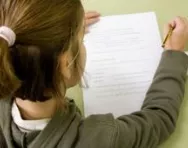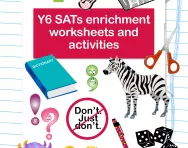Exam revision planner for SATs and beyond

Get your child off to a confident start with these exam revision tips for SATs and other school exams from top parenting expert Sue Atkins.
No one looks forward to exams. But if your children are organised, they don’t have to be the stuff of nightmares and they can even find time for some fun in between swotting up. Here’s our guide to stress-less revision.
Create an action plan
Help your child to find a good place to work. It must be quiet, well-lit and free from chocolate wrappers and sports socks!


Prepare your child for SATs today
- Your guide to SATs
- SATs revision courses
- SATs practice papers in English & maths
Next, draw up a revision timetable together, as the odd hour here and there isn’t enough. Encourage them to mix up their weak subjects with their favourites, so they don’t lose confidence by focusing just on the tricky ones. To keep them motivated, help them set achievable targets, which they can tick off each day, and celebrate those small successes.
Remember that their timetable should also include breaks and mealtimes. Encourage them to take time out for a walk around the block with the dog, a bike ride, or to listen to some music. Giving their brain and eyes a rest is important. They’ll come back refreshed and able to absorb information again.
Use memory tricks
For older children, encourage them to make their own revision notes because they will start learning as soon as they write them out. Also when they re-read them they'll make more sense, as they’ll be in their own words. Encourage them to make notes short and sharp, sticking to the main points. They can also write key facts on post-it notes to pop on the fridge or in their bedroom.
To help your child remember key facts, make up silly mnemonics or rhymes. For example, for a younger child trying to learn how to spell ‘because’ you could use, ‘big elephants cause accidents under small elephants.’
Highlighter pens are handy too, as your child can mark key areas in their notes with different colours. Mind maps and diagrams can also help.
Match their learning style
If your child is an auditory learner, get them to record their notes on an iPod or CD, so they can listen to them. Also help them recite their notes out loud.
If your child is a visual learner, offer them coloured pens and highlighters so they can write notes and draw pictures to help them remember facts.
If your child is more of a kinaesthetic learner (they like to be active when learning), encourage them to move around the room while they recite information. Try to provide multimedia resources, such as a computer or video camera to help them study, too.
For most children, regularly testing their knowledge helps – they can get a friend or family member to help – to check what they need to go over again. Older children can try doing past exam papers against the clock, too.
Stay positive
Help your child to get into a positive, confident frame of mind. Get them to think of five things they are really good at and visualise themselves doing those things, thinking about how they make them feel. As your child goes into their exam, they can then remember those feelings to help them relax.
Remember to help them keep the bigger picture in mind, too. Although exams are important they are only one aspect of life and they need to be kept in perspective. Good luck!

Give your child a headstart
- FREE articles & expert information
- FREE resources & activities
- FREE homework help
By proceeding you agree to our terms and conditions. For information on how we use your data, see our privacy policy. You will receive emails from us but can opt out at any time.







